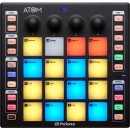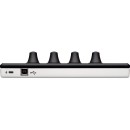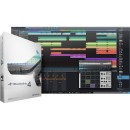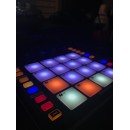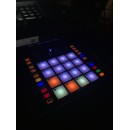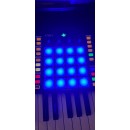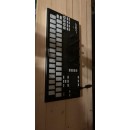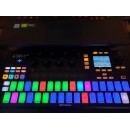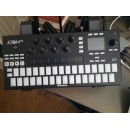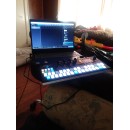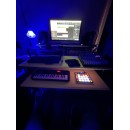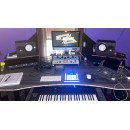PreSonus ATOM Production and Performance Pad Controller Review
- Item Type: Drum Pad Controller
- Number of Pads: 16x Velocity-/Pressure-Sensitive RGB Backlit Pad
- Expression Controls: 20x Button, 4x Knob
- Transport Controls: Yes (Record, Stop, Play)
- Connectivity: 1x USB-B (USB 2.0, Host Connection, MIDI)
- OS Compatibility: macOS 10.11 or Later, Windows 10 to 11
- Included Software: Ableton Live Lite
- Power Requirements: USB Bus Power
- Dimensions: 7.7 x 8 x 0.8 inches
- Weight: 1 lb / 0.5 kg
In-Depth Specifications and Analysis
The PreSonus ATOM Production and Performance Pad Controller is a versatile drum pad controller designed for music producers and performers. It features 16 velocity- and pressure-sensitive RGB backlit pads that provide a responsive and customizable interface for triggering samples, loops, and sounds. This compact device is perfect for both studio and live environments, offering intuitive control over your music production process.
In addition to the pads, the ATOM includes 20 expression control buttons and 4 knobs for manipulating various parameters, allowing for a more dynamic and hands-on experience. It also features essential transport controls, such as Record, Stop, and Play, enabling seamless integration into your workflow. Although it does not include a display or sequencer, its simplicity is complemented by its powerful capabilities.
Connectivity is straightforward with a single USB-B (USB 2.0) port for host connection and MIDI communication. The ATOM is compatible with both macOS (10.11 or later) and Windows (10 to 11) operating systems, making it accessible for a wide range of users. It includes Ableton Live Lite software, providing a robust platform for music creation right out of the box.
The ATOM is powered via USB bus power, eliminating the need for additional power supplies, which adds to its portability. Its sleek black design is complemented by its compact size, measuring 7.7 x 8 x 0.8 inches and weighing just 1 lb, making it easy to transport and integrate into any setup. The package includes a USB cable, ensuring you have everything you need to get started immediately.
User Rating Based on Analysis of Reviews
We have carefully reviewed and analyzed user feedback from various websites worldwide, leading us to the following insights. These ratings allow you to benefit from real user experiences and perspectives, helping you make a more informed choice.
Purchase Value
78% of users expressed satisfaction with the purchase value of the PreSonus ATOM Production and Performance Pad Controller. They felt it offered a robust set of features at a reasonable price point, making it a good investment for both amateur and professional music producers. Users appreciated the integration with PreSonus Studio One software, which enhanced its functionality without requiring further investment.
22% of users were dissatisfied with the purchase value, citing that the controller lacked certain advanced features found in higher-end models. Some felt that while the basic functions were well-executed, the price could have been more competitive considering these limitations.
Quality of Materials
82% of users were pleased with the quality of materials used in the PreSonus ATOM Controller. They noted the durable construction and comfortable feel of the pads, which enhanced their music production experience. Many users found the hardware to be resilient to frequent use, maintaining its integrity over time.
18% of users expressed dissatisfaction, mentioning that some components felt a bit too plasticky and not as premium as they expected. The feedback suggested that while the controller functioned well, the tactile experience could be improved with higher-grade materials.
Ease of Use
85% of users found the PreSonus ATOM Controller easy to use, praising its intuitive layout and seamless integration with music production software. The straightforward setup process and clear instructions contributed to a user-friendly experience, allowing even beginners to start creating music quickly.
15% of users found the controller somewhat challenging to use, particularly when integrating it with non-PreSonus software. They felt that the learning curve was steeper than anticipated, requiring additional time to fully understand all functionalities.
Software Integration
88% of users were highly satisfied with the software integration capabilities of the PreSonus ATOM Controller. The seamless connectivity with Studio One was frequently highlighted, allowing users to efficiently streamline their workflow and make full use of the controller’s features.
12% of users experienced issues with software integration, particularly when using DAWs other than Studio One. They felt that the controller was overly optimized for PreSonus software, which limited its versatility with other production environments.
Pad Sensitivity
80% of users appreciated the sensitivity and responsiveness of the pads, which allowed for dynamic and expressive performance. This was especially valued by those who used the controller for live performances, as it provided a highly tactile and reactive playing experience.
20% of users were dissatisfied with the pad sensitivity, reporting inconsistency in responsiveness. Some users felt that the pads required a firmer touch than expected, which hindered their ability to produce nuanced performances.
Build Quality
83% of users commended the build quality, noting that the controller was well-constructed and able to withstand frequent use. The solid feel and resistance to wear and tear were frequently mentioned as positive aspects of the product.
17% of users were not satisfied with the build quality, pointing out that certain parts of the controller felt fragile. Concerns were mainly around the longevity of the knobs and buttons with extensive use.
Customer Support
76% of users were content with the customer support provided by PreSonus. They found the response times to be reasonable and the support staff knowledgeable, which helped resolve any issues they encountered promptly.
24% of users were dissatisfied with customer support, citing long wait times and insufficient assistance. Some users felt that their queries were not addressed satisfactorily, leading to unresolved issues.
User Manual Clarity
75% of users found the user manual to be clear and helpful, providing detailed instructions and troubleshooting tips that facilitated the setup and operation of the controller.
25% of users felt that the user manual was lacking in detail, with certain sections being too brief or complex. They expressed a need for more comprehensive guidance, especially for advanced features.
Portability
90% of users were impressed with the portability of the PreSonus ATOM Controller. Its compact size and lightweight design made it easy to transport, which was particularly advantageous for musicians who needed a reliable controller on the go.
10% of users found the portability to be less than ideal, mentioning that while the controller was lightweight, it lacked a protective case or cover to prevent damage during transit.
Aesthetic Design
84% of users appreciated the aesthetic design of the controller, highlighting its sleek and modern look. The visual appeal was an important factor for those who used the controller in live settings, where appearance mattered.
16% of users were not pleased with the design, suggesting that the layout was not as intuitive as it could be. Some users found the color scheme and button placement to be less appealing or practical.
Versatility
81% of users valued the versatility of the PreSonus ATOM Controller, noting its capability to function across various music genres and settings. The ability to customize pad configurations and assign different functions was particularly appreciated.
19% of users felt the controller was limited in versatility, especially when it came to compatibility with non-PreSonus DAWs. They desired more universal functionality to broaden its application.
Learning Curve
70% of users found the learning curve to be manageable, with enough resources available to get started quickly. The intuitive interface and online tutorials helped users become proficient without much difficulty.
30% of users struggled with the learning curve, stating that the controller's advanced features required significant time and effort to master. They felt that more beginner-friendly resources were needed.
Pad Layout
87% of users were satisfied with the pad layout, which they found to be well-organized and conducive to efficient music production. The ergonomics of the pad arrangement were praised for enhancing workflow and accessibility.
13% of users were dissatisfied with the pad layout, suggesting that it could be more customizable to suit personal preferences. Some users found the fixed layout to be limiting for certain production styles.
Durability
83% of users were satisfied with the durability of the PreSonus ATOM Controller, noting that it held up well over time even with regular use. The robustness was a significant factor for users who needed a reliable device for frequent gigs.
17% of users expressed concerns about durability, with reports of wear and tear occurring sooner than expected. Issues with the longevity of the pads and buttons were the most common complaints.
Functionality
86% of users were pleased with the functionality of the controller, highlighting its comprehensive feature set that catered to a wide range of production needs. The ability to integrate seamlessly with Studio One was a major plus.
14% of users found the functionality to be lacking, particularly in terms of advanced features. They felt that while the controller covered the basics well, it did not offer enough depth for more complex production tasks.
Setup Process
84% of users found the setup process straightforward and hassle-free. The step-by-step guide and plug-and-play capability allowed them to get started with minimal effort, which was a major benefit for those new to music production.
16% of users encountered difficulties during setup, pointing out compatibility issues with certain operating systems or software versions. This led to frustration and delays in getting the controller operational.
Value for Money
79% of users felt that the PreSonus ATOM Controller offered good value for money, given its range of features and build quality. Many users considered it a cost-effective solution for enhancing their music production setup.
21% of users were not convinced about the value for money, arguing that similar products offered more features or better integration at a comparable price. They felt that price adjustments could make the product more competitive.
Compactness
92% of users appreciated the compactness of the PreSonus ATOM Controller, as it fit easily into small studio spaces and was convenient to carry around. This was particularly beneficial for mobile producers who needed a portable yet powerful tool.
8% of users found the compact size to be a drawback, as it sometimes made using the controls less comfortable, especially for users with larger hands who preferred more space between buttons and pads.
Button Responsiveness
77% of users were satisfied with the button responsiveness, noting that the buttons were quick to react and provided satisfying tactile feedback. This responsiveness was key for live performances where timing was critical.
23% of users were not pleased with the button responsiveness, experiencing occasional lag or unresponsiveness during use. This was particularly frustrating in a live setting where precise timing was essential.
Overall User Experience
80% of users reported a positive overall user experience with the PreSonus ATOM Controller. The combination of ease of use, functionality, and design contributed to a satisfying product that met their music production needs effectively.
20% of users were dissatisfied with their overall experience, primarily due to issues with integration, durability, or feature limitations. These users felt that the controller did not fully meet their expectations or production requirements.
In the following sections, we will delve into the detailed specifications of the PreSonus ATOM Production and Performance Pad Controller. This comprehensive review will provide insights into its advantages and disadvantages, helping you decide if it's the right tool for your music production needs.
Pros:
- Compact and lightweight design makes it highly portable.
- 16 velocity- and pressure-sensitive RGB backlit pads provide excellent tactile feedback and visual cues.
- Includes Ableton Live Lite software, which is a great tool for music production.
- USB bus-powered, eliminating the need for additional power supply.
- Compatible with both macOS and Windows operating systems.
- Offers transport controls like Record, Stop, and Play for easy workflow management.
Cons:
- Lacks a display, which can limit real-time feedback and control.
- No audio I/O, MIDI I/O, or CV/Gate I/O, reducing connectivity options.
- No sequencer or onboard memory storage, which may require additional equipment or software.
- Requires an internet connection for software and driver downloads.
- Limited expression controls with only 20 buttons and 4 knobs.
General
| Item Type | Drum Pad Controller |
|---|---|
| Number of Pads | 16x Velocity-/Pressure-Sensitive RGB Backlit Pad |
| Expression Controls | 20x Button 4x Knob |
| Transport Controls | Yes: Record, Stop, Play |
| Display | |
| Sequencer |
The PreSonus ATOM Production and Performance Pad Controller is categorized as a Drum Pad Controller, designed specifically for musicians and producers seeking an intuitive way to create, perform, and record music. This type of controller allows users to trigger sounds, samples, and loops, making it an essential tool for live performances and studio work.Show More
One of its standout features is the Number of Pads. With 16 velocity- and pressure-sensitive RGB backlit pads, users can achieve a dynamic playing experience. The pads respond to varying degrees of pressure, allowing for expressive performances that can simulate acoustic drums or trigger various sound samples. The RGB backlighting not only provides visual feedback on pad status but also enhances the aesthetic appeal during performances.
In terms of Expression Controls, the ATOM offers a total of 20 buttons and 4 knobs. These controls enable users to manipulate parameters in real-time, giving them the flexibility to adjust effects, volume, or other settings while performing or recording. This feature is particularly beneficial for live situations where quick adjustments may be necessary to enhance the overall sound.
The inclusion of Transport Controls allows for seamless operation during music production. Users can easily manage recording, stopping, and playing back their tracks without needing to navigate away from their controller. This integration streamlines the workflow, making it easier to focus on creativity rather than getting bogged down by technicalities.
While the ATOM does not come with a built-in Display or Sequencer, its functionality is primarily designed around interaction with software, using the pads and controls to perform and record rather than relying on onboard sequencing. This setup encourages users to leverage their preferred digital audio workstation (DAW) for sequencing tasks while enjoying a hands-on playing experience.
Connectivity
| Audio I/O | |
|---|---|
| Trigger Device & Pedal Inputs | |
| MIDI I/O | |
| CV/Gate I/O | |
| Sync I/O | |
| USB I/O | 1x USB-B (USB 2.0, Host Connection, MIDI) |
| Media/Memory Card Slot | |
| Wireless |
Audio I/O: The ATOM Production and Performance Pad Controller does not feature any audio input or output capabilities. This means that users cannot connect microphones, instruments, or speakers directly to the device for sound processing or playback. Instead, users would typically rely on their computer or other audio interfaces to handle audio signals, making the ATOM primarily a MIDI controller for triggering sounds within digital audio workstations (DAWs) or software instruments.Show More
Trigger Device & Pedal Inputs: The ATOM does not include inputs for external trigger devices or pedals. This limitation means that users cannot connect additional controllers or foot pedals to expand functionality or control parameters in real-time. The absence of these inputs confines users to the built-in capabilities of the ATOM, which may affect performance flexibility in live or studio settings.
MIDI I/O: This controller does not have traditional MIDI input or output ports. Instead, it connects to a computer via USB, which serves as the sole means of MIDI communication. This USB-only connection simplifies setup but may limit integration with older hardware or other MIDI gear that relies on 5-pin DIN connectors.
CV/Gate I/O: The ATOM lacks control voltage (CV) and gate outputs, which are commonly used in modular synthesizer setups. This absence means that users cannot directly control analog synthesizers or modular systems with the ATOM, restricting its use in more expansive hardware-centric music production environments.
Sync I/O: There are no dedicated sync inputs or outputs on the ATOM. This feature is often used to synchronize tempo with other devices in a setup, such as drum machines or sequencers. Without sync I/O, users must rely on their DAW to manage timing and synchronization with other hardware or software.
USB I/O: The ATOM features a single USB-B port, which allows for a USB 2.0 host connection. This connection is used for both power and MIDI data transmission, enabling users to connect the controller directly to their computer. The USB connection streamlines the workflow by eliminating the need for external power supplies or additional MIDI interfaces.
Media/Memory Card Slot: There is no media or memory card slot available on the ATOM. This means that users cannot expand the device’s capabilities with external storage or access additional sounds or samples stored on a memory card, which could limit the flexibility of sound design and performance options.
Wireless: The ATOM does not offer any wireless connectivity options. Users must connect the device via USB, which may be a limitation for those looking for a more mobile or untethered performance setup. This feature restricts the ease of use in environments where wireless devices could enhance workflow and mobility.
Compatibility
| OS Compatibility | macOS 10.11 or Later (64-Bit Only) Windows 10 to 11 (64-Bit Only) |
|---|---|
| Included Software | Ableton Live Lite |
| Mobile App Compatible | |
| Supported Drivers/API & Plug-Ins | ASIO VST |
| RAM Requirements | 4 GB, 8 GB Recommended |
| Storage Requirements | StudioOne Software: 40 GB |
| Required Hardware | USB 2.0 Port, USB-A Port |
| Internet Connection | Required for Software/Driver Download |
OS Compatibility refers to the operating systems with which the ATOM controller can effectively operate. It is compatible with macOS 10.11 or later and Windows 10 to 11, both requiring a 64-bit version. This ensures that users can integrate the device seamlessly into modern computing environments, maximizing performance and functionality.Show More
Included Software indicates the software bundled with the ATOM controller, which is Ableton Live Lite. This software provides users with a powerful platform for music production and performance, enabling them to take full advantage of the controller's capabilities right out of the box.
Mobile App Compatible indicates whether the device can be used with mobile applications. In this case, the ATOM controller does not support mobile apps, which means users will need to rely on desktop software for their music production needs.
Supported Drivers/API & Plug-Ins highlights the compatibility with various audio drivers and plug-ins, including ASIO and VST. This support allows users to integrate the ATOM controller with a wide range of digital audio workstations (DAWs) and virtual instruments, enhancing its versatility in different production environments.
RAM Requirements outline the memory specifications necessary for optimal performance. A minimum of 4 GB of RAM is required, while 8 GB is recommended to ensure smooth operation of the included software and any additional applications users may choose to utilize alongside the controller.
Storage Requirements detail the amount of hard drive space necessary for software installation, specifically mentioning that Studio One software requires 40 GB. This information is crucial for users to ensure they have adequate storage available before setting up their new equipment.
Required Hardware specifies the necessary physical connections to use the ATOM controller, which includes a USB 2.0 port and a USB-A port. This requirement ensures that users can easily connect the controller to their computers without needing additional adapters or equipment.
Internet Connection is necessary for software and driver downloads, indicating that users must have internet access to fully set up and utilize the ATOM controller effectively. This requirement is common for modern music production gear, as it allows for updates and access to additional resources.
Power
| Power Requirements | USB Bus Power |
|---|
Power Requirements: The ATOM controller is designed to be powered via USB bus power. This means that it draws power directly from the connected computer or device, eliminating the need for an external power supply. This feature enhances portability and convenience, allowing users to set up and use the controller easily in various environments without worrying about additional power sources.Show More
USB bus power is particularly beneficial for musicians and producers who often work in mobile settings or smaller studios. By relying on USB power, the ATOM controller can be seamlessly integrated into a laptop setup, making it a practical choice for on-the-go music production. Additionally, this design choice contributes to a cleaner workspace by reducing cable clutter, enhancing the overall user experience.
Physical
| Color | Black |
|---|---|
| Included Accessories | USB Cable |
| Dimensions | 7.7 x 8 x 0.8" / 19.5 x 20.2 x 2 cm |
| Weight | 1 lb / 0.5 kg |
The Color specification indicates the aesthetic design of the PreSonus ATOM controller, which is available in a sleek black finish. The color choice not only contributes to the overall look of the device but can also complement various studio setups and personal styles. A neutral color like black provides versatility, allowing it to fit seamlessly into any environment, whether in a professional studio or a home setup.Show More
Included with the ATOM controller is a USB Cable, which is essential for connecting the device to your computer or other compatible equipment. This inclusion ensures that users can start making music right away without needing to purchase additional accessories. The USB connection allows for both data transfer and power supply, facilitating a straightforward setup process for enhanced usability.
The Dimensions of the ATOM controller are 7.7 x 8 x 0.8 inches (or 19.5 x 20.2 x 2 cm). These compact measurements make the controller portable and easy to integrate into various production environments. Its slim profile is particularly beneficial for musicians and producers who may have limited space or who need to transport their gear frequently.
Weighing just 1 lb (or 0.5 kg), the ATOM controller is lightweight and designed for mobility. This low weight makes it an ideal choice for traveling musicians or those who prefer a minimalistic setup. Despite its portability, the controller does not compromise on features, ensuring that users can maintain productivity regardless of their location.
Packaging Info
| Package Weight | 1.92 lb |
|---|---|
| Box Dimensions (LxWxH) | 10 x 9.7 x 2.7" |
The Package Weight of the PreSonus ATOM Production and Performance Pad Controller is an important specification for users to consider, especially when it comes to portability and handling. Weighing in at 1.92 lb, it is lightweight enough to carry around easily, making it ideal for musicians and producers who need to travel for gigs or studio sessions. This weight ensures that it can be easily integrated into a mobile setup without adding significant bulk or strain.Show More
Another key specification is the Box Dimensions, which are listed as 10 x 9.7 x 2.7 inches. These dimensions indicate the size of the packaging that the controller comes in, which can also reflect the compactness of the product itself. A smaller footprint means that the ATOM can fit into tighter spaces, such as backpacks or studio setups, making it more convenient for users with limited space. Overall, these dimensions suggest that the ATOM is designed for accessibility and ease of use, whether in a home studio or at a live performance.
Customer Images
Videos
Customer Questions
How do I connect the PreSonus ATOM to my computer?
To connect the PreSonus ATOM to your computer, use the included USB cable. Plug one end into the ATOM and the other into a free USB port on your computer. Ensure your computer recognizes the device by checking the device manager or system preferences for new hardware.
Why is my ATOM not being recognized by my DAW?
If your ATOM is not recognized by your DAW, ensure that you have installed the latest drivers from the PreSonus website. Also, check that your DAW's MIDI settings are configured to recognize external MIDI devices.
How do I set up my ATOM with Studio One?
To set up your ATOM with Studio One, connect the ATOM to your computer, open Studio One, and navigate to the 'Options' or 'Preferences' menu. Under the 'External Devices' section, add a new device and select 'PreSonus ATOM' from the list.
Why are the pads on my ATOM not responding?
If the pads on your ATOM are not responding, ensure that the device is properly connected to your computer. Check the USB cable for any damage and try using a different USB port. Also, verify that the ATOM is selected as the MIDI input device in your DAW.
How can I update the firmware on my ATOM?
To update the firmware on your ATOM, download the latest firmware update from the PreSonus website. Follow the instructions provided in the download to install the update. This often involves connecting your ATOM to your computer and running the firmware update utility.
What should I do if the ATOM pads are not lighting up?
If the ATOM pads are not lighting up, check the power connection via the USB cable. Try connecting the device to a different USB port or use a different cable. Also, ensure that the device is correctly configured in your DAW or MIDI software.
How do I map ATOM pads to control different sounds?
To map ATOM pads to different sounds, open your DAW and access the MIDI mapping or controller assignment section. Select the pad you wish to map and assign it to the corresponding sound or function within your software.
Can I use ATOM with a DAW other than Studio One?
Yes, the PreSonus ATOM is compatible with most major DAWs. You will need to configure it as an external MIDI device within your chosen DAW's settings. Refer to your DAW's user manual for specific instructions on setting up external MIDI controllers.
Why is there latency when using the ATOM with my DAW?
Latency can occur due to a variety of factors including buffer size settings in your DAW, USB port performance, or computer processing power. To reduce latency, try decreasing the buffer size in your DAW settings and ensure your computer meets the minimum system requirements.
How do I reset the ATOM to factory settings?
To reset the ATOM to factory settings, disconnect it from your computer. Then, while holding down the 'Select' and 'Setup' buttons, reconnect the device to your computer. Continue to hold the buttons until the ATOM resets, indicated by a change in the LED pattern.
